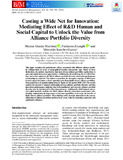Casting a wide net for innovation: mediating effect of R&D human and social capital to unlock the value from alliance portfolio diversity
Fecha
2019Versión
Acceso abierto / Sarbide irekia
Tipo
Artículo / Artikulua
Versión
Versión publicada / Argitaratu den bertsioa
Impacto
|
|
10.1111/1467-8551.12310
Resumen
This paper examines the performance effects associated with different alliance portfolio configurations in terms of geographical location and partner type. Based on these distinctions, the authors hypothesize that more diverse alliance portfolios enable firms to gain and exploit innovation opportunities. Additionally, the mediating effects of R&D human and social capital on the R&D alliance portf ...
[++]
This paper examines the performance effects associated with different alliance portfolio configurations in terms of geographical location and partner type. Based on these distinctions, the authors hypothesize that more diverse alliance portfolios enable firms to gain and exploit innovation opportunities. Additionally, the mediating effects of R&D human and social capital on the R&D alliance portfolio diversity-innovation performance relationship are explored. The authors reason that the absorptive capacity of R&D intellectual capital determines a firm's potential gains from highly diverse alliance portfolios. From panel data of manufacturing firms in Spain for the period 2008-2013, the results confirm the inverted U-shaped relationship between alliance portfolio diversity and firm innovation performance, implying that both insufficient and excessive alliance portfolio diversity may be detrimental to firm innovativeness. Additionally, R&D human and social capital partially mediates the R&D alliance diversity-innovation performance relationship, emphasizing the importance of internal capabilities to leverage the benefits of highly diverse alliance portfolios. These findings add a dynamic dimension to the conceptualization of alliance portfolios and how firms create value by balancing explorative and exploitative alliances. [--]
Materias
Research and development,
Management,
Alliance portfolio diversity
Editor
Wiley
Publicado en
British Journal of Management, 2019, 30 (4), 769-790
Departamento
Universidad Pública de Navarra. Departamento de Gestión de Empresas /
Nafarroako Unibertsitate Publikoa. Enpresen Kudeaketa Saila /
Universidad Pública de Navarra/Nafarroako Unibertsitate Publikoa. Institute for Advanced Research in Business and Economics - INARBE
Versión del editor
Entidades Financiadoras
The authors gratefully acknowledge the funding received through the AGL2015-65897-C3-1 research project co-financed by FEDER, and they would also like to express their gratitude for the financial support received from the Public University of Navarra for the acquisition of the pre-doctoral scholarship (Modality type B).
Aparece en las colecciones
Los documentos de Academica-e están protegidos por derechos de autor con todos los derechos reservados, a no ser que se indique lo contrario.
La licencia del ítem se describe como © Authors 2019. This is an open access article under the terms of the Creative Commons Attribution-NonCommercial License, which
permits use, distribution and reproduction in any medium, provided the original work is properly cited and is not used
for commercial purposes.







